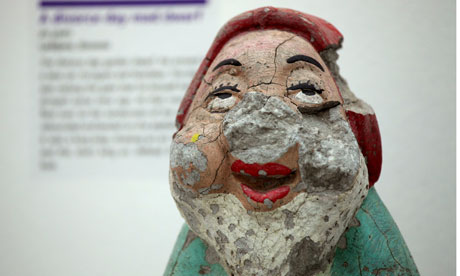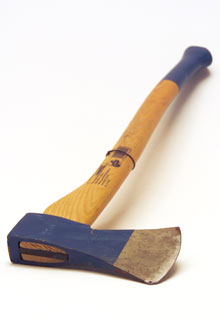My contribution to the museum of broken relationships.
A phial of my toxic blood.
I was so desperate for his baby. He made me wait and wait, giving me just enough hope to keep hanging in there; we bought a house together, had a future. When he finally said we could try I was too old and had several miscarriages. He left me when I was pregnant for a much younger woman who was also pregnant with his child. My baby turned out not to be a baby at all but a possibly cancerous tumour growing around a piece of tooth or a hairball. Going (alone) for a scan and discovering, not just that your baby is dead but that, in fact, it never even was a baby and instead is a tumour around a hairball is a frightening version of a fairytale.
All blood races to the womb when you are pregnant to feed your baby - or baby tumour, in my case. Hydratitform moles, as the tumours are called, cause a highly virulent cancer which spreads very fast throughout the whole body. For this reason for the next few years I had to go, once a month, and have my blood taken and then go somewhere else and have the serum spun, and then package it up and send it to a lab.
It took me longer than five years to get over the loss of him and his babies, as I had such a strong picture of them in my head. Years before I had torn a picture of a little girl from a GAP ad. I thought she looked exactly like the child we would have. Strangely enough that child looks exactly like the one the children he had with the other woman, who became his wife.
I don't know why this phial was never sent off, maybe it came after I had the all clear. I think I kept it because it was the big red light that finally stopped me wanting his baby. In the end my life was too precious to try to get pregnant again.
The museum is a beautiful exercise in schadenfreude and I hope my exhibit is would have been a worthy addition. I'm not in the least sad about any of that now. I'm friends with the ex and his whole family and feel totally at one with the situation. I am happy with my gorgeous adopted daughter who has no connection to this toxic blood. Strangely, however, I'm too attached to my old blood to give it away. It's calcified, (or solidified or something even more gross) in the last few years and isn't really a beautiful thing.
I suppose it reminds me how lucky I am to have the life I am living now.
This is the best review of the museum of broken relationships that I have read:
I was so desperate for his baby. He made me wait and wait, giving me just enough hope to keep hanging in there; we bought a house together, had a future. When he finally said we could try I was too old and had several miscarriages. He left me when I was pregnant for a much younger woman who was also pregnant with his child. My baby turned out not to be a baby at all but a possibly cancerous tumour growing around a piece of tooth or a hairball. Going (alone) for a scan and discovering, not just that your baby is dead but that, in fact, it never even was a baby and instead is a tumour around a hairball is a frightening version of a fairytale.
All blood races to the womb when you are pregnant to feed your baby - or baby tumour, in my case. Hydratitform moles, as the tumours are called, cause a highly virulent cancer which spreads very fast throughout the whole body. For this reason for the next few years I had to go, once a month, and have my blood taken and then go somewhere else and have the serum spun, and then package it up and send it to a lab.
It took me longer than five years to get over the loss of him and his babies, as I had such a strong picture of them in my head. Years before I had torn a picture of a little girl from a GAP ad. I thought she looked exactly like the child we would have. Strangely enough that child looks exactly like the one the children he had with the other woman, who became his wife.
I don't know why this phial was never sent off, maybe it came after I had the all clear. I think I kept it because it was the big red light that finally stopped me wanting his baby. In the end my life was too precious to try to get pregnant again.
The museum is a beautiful exercise in schadenfreude and I hope my exhibit is would have been a worthy addition. I'm not in the least sad about any of that now. I'm friends with the ex and his whole family and feel totally at one with the situation. I am happy with my gorgeous adopted daughter who has no connection to this toxic blood. Strangely, however, I'm too attached to my old blood to give it away. It's calcified, (or solidified or something even more gross) in the last few years and isn't really a beautiful thing.
I suppose it reminds me how lucky I am to have the life I am living now.
This is the best review of the museum of broken relationships that I have read:
Display of affection
Every object tells a story and none more so than the items donated by lovers (and ex-lovers) to Zagreb's new Museum of Broken Relationships

A garden gome after being hurled in fury at a windscreen - on show in the Zagreb Museum of Broken Relationships.
There are, no doubt, people who marry the first person who takes their fancy and spend the rest of their lives in unalloyed happiness. For them,Zagreb's newest museum will be baffling. But everybody else, which is to say almost everybody else, will know the feeling to which the Museum of Broken Relationships is dedicated. It is that miasma of guilt, nostalgia, anger and affection that comes of contemplating certain of our possessions.
They are often of little, if any, intrinsic worth, but they hold or held value because of who gave them to us. Whether we keep them, bin them or burn them in pentangles while chanting incantations and spritzing them with holy water, they will always mean something.
The exhibits in the Museum of Broken Relationships are as random and varied as the reasons people get together, and break up. Each item is presented with a summary of the dates and locations of the relationship, and annotations by their donors.
Some are funny. The caption on a suspender belt, purchased in Sarajevo in 2003, reflects: "I never put them on. The relationship might have lasted longer if I had." Another, on a tin sold as "Love Incense", merely reads, "Doesn't work." Some are gleefully vindictive. The label by a blue Frisbee reads: "Darling, should you ever get the ridiculous idea to walk into a cultural institution like a museum for the first time in your life, you'll remember me." One or two are quietly devastating: a small, electronic dog tag, still flashing like a heart monitor, which was given to a man who left, by the woman who loved him, shortly before she killed herself.
The museum is the work of designer and artist Drazen Grubisic and film producer Olinka Vistica. One of the first exhibits is a small white wind-up rabbit – a relic of Grubisic and Vistica's own relationship, which foundered six years ago. The idea for the museum came, they tell me, from their discussions about splitting their possessions.
"It's easy to decide about stereos, and televisions," says Grubisic. "But what about these tokens?"
"And the memories they represent," adds Vistica, "how do you protect them from oblivion?"
 Find out what a spurned lover did with this axe.
Find out what a spurned lover did with this axe.This question turned into an installation in a Zagreb biennale in 2006, then a travelling show which visited several countries, acquiring more objects, and more stories. The museum moved into this permanent home, in Gornji Grad – Zagreb's upper town, where most of what's worth seeing in the city is situated – last October. The location is at once convenient and appropriate: though it's only a short walk from here to the open-air market of Dolac and the cafe district of Tkalciceva Street, this part of Zagreb has a mournful, somewhat desolate air at this time of year. The cobbled streets between the handsome buildings are empty in the winter fog; the square around the 14th-century St Mark's church, a building best described as Legoland Gothic, is all but deserted.
On sale in the gift shop are T-shirts by young Croatian designers – they're heavy on teardrop motifs. The biggest-selling item, the receptionist says, is a white rubber with the words "bad memories eraser".
There's also a book of big, blank pages and a pen, so that visitors can add their own testimonies. This is as compelling as the exhibition itself, a compendium of disappointment and desolation, some lyrical, some pithy ("I think I still hate you, Darren").
The museum manages to come across as neither a playground for self-pity, nor an advocacy centre for mindlessly positive uplift. A modest manifesto on one wall suggests that it represents, rather, "a chance to overcome an emotional collapse through creation, by contributing to the museum's collection".
It is an exercise in schadenfreude and solidarity. There's always someone worse off, like the woman who was presented with a candy G-string ("After four years, he turned out to be as cheap and shabby as his presents"). And there are those clearly once beside themselves with anger or jealousy, who have bequeathed the axe with which they smashed the furniture, the wing mirror they wrenched off the car, the gnome injured after being hurled at a windscreen.
The museum's founders have plans to expand their remit to include artistic and cultural performances, to revive this part of Zagreb, and by way of acknowledgement that no other subject has inspired more literature, more music.
Grubisic and Vistica have stopped formally soliciting donations, but they receive them more or less constantly anyway: most recent was a collection of half-century old postcards, sent by an elderly woman in Yerevan, Armenia.
"Older people tend to take it more seriously," says Grubisic. "They are often really moved. Kids haven't had the experience. It's funny when couples come in. Some are laughing, but some … some are really thinking."
• The Museum of Broken Relationships (brokenships.com; entrance £2.50pp). Croatia Airlines (croatiaairlines.com) flies from Gatwick and Heathrow to Zagreb from £85 return. Doubles at the historic Regent Esplanade hotel (regenthotels.com) cost from £126


No comments:
Post a Comment